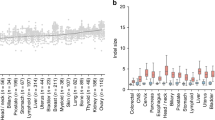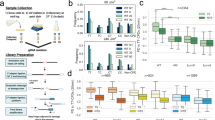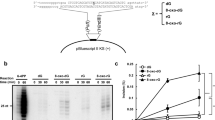Abstract
IN differentiated cells, only a specific subset of genes is expressed. Recently, several genes have been shown to be transcriptionally inactivated by methylation of cytosine residues, mainly within their promoter sequences1–4. Spontaneous hydrolytic deamination of 5-methylcytosine to thymine5, which has been estimated to generate up to 12 G-T mismatched base pairs in the human genome per day6,7, could have a deleterious effect on the expression of such genes. We recently reported that mammalian cells possess a specific repair pathway, which counteracts the mutagenic effects of this deamination by correcting G ṁ T mismatches almost exclusively to G ṁ C pairs8,9. We show here that, in nuclear extracts from HeLa cells, this repair is mediated by excision of the aberrant thymidine monophosphate residue, followed by gap-filling to generate a G ṁ C pair. We also provide preliminary evidence that the initial step of this process involves a DNA glycosylase.
This is a preview of subscription content, access via your institution
Access options
Subscribe to this journal
Receive 51 print issues and online access
$199.00 per year
only $3.90 per issue
Buy this article
- Purchase on Springer Link
- Instant access to full article PDF
Prices may be subject to local taxes which are calculated during checkout
Similar content being viewed by others
References
Bird, A. P. Nature, 321, 209–213 (1986).
Doerfler, W. et al. Prog. clin. biol. Res. 198, 133–155 (1985).
Gardiner-Garden, M. & Frommer, M. J. molec. Biol. 196, 261–282 (1987).
Ben-Hattar, J. & Jiricny, J. Gene 65, 219–227 (1988).
Riggs, A. D. & Jones, P. A. Adv. Cancer Res. 40, 1–30 (1983).
Lindahl, T. A. Rev. Biochem. 51, 61–87 (1982).
Wang, R. Y.-H., Kuo, K. C., Gehrke, C. W., Huang, L.-H. & Ehrlich, M. Biochim. biophys. Acta 697, 371–377 (1982).
Brown, T. C. & Jiricny, J. Cell 50, 945–950 (1987).
Brown, T. C. & Jiricny, J. Cell 54, 705–711 (1988).
Jiricny, J., Wood, S. G., Martin, D. & Ubasawa, A. Nucleic Acids Res. 14, 6579–6590 (1986).
Maxam, A. M. & Gilbert, W. Proc. natn. Acad. Sci. U.S.A. 74, 560–564, (1977).
Jiricny, J., Hughes, M., Corman, N. & Rudkin, B. B. Proc. natn. Acad. Sci. U.S.A. 85, 8860–8864, (1988).
Modvich, P. A. Rev. Biochem 56, 435–466 (1987).
Lieb, M. Molec. Gen. Genet. 199, 465–470 (1985).
Zell, R. & Fritz, H.-J. EMBO J. 6, 1809–1815 (1987).
Jones, M., Wagner, R. & Radman, M. J. Molec. Biol. 194, 155–159 (1987).
Lu, A-L., Chang, D-Y. Cell 54, 805–812, (1988).
Au, K. G., Cabrera, M., Miller, J. H. & Modrich, P. Proc. natn. Acad. Sci. U.S.A. 85, 9163–9166, (1988).
Dignam, D. J., Lebovitz, R. M. & Roeder, R. G. Nucleic Acids Res. 11, 1475–1489, (1983).
Krämer, A. and Keller, W. Meth. Enzymol. (in the press).
Author information
Authors and Affiliations
Rights and permissions
About this article
Cite this article
Wiebauer, K., Jiricny, J. In vitro correction of G o T mispairs to G o C pairs in nuclear extracts from human cells. Nature 339, 234–236 (1989). https://doi.org/10.1038/339234a0
Received:
Accepted:
Issue Date:
DOI: https://doi.org/10.1038/339234a0
This article is cited by
Comments
By submitting a comment you agree to abide by our Terms and Community Guidelines. If you find something abusive or that does not comply with our terms or guidelines please flag it as inappropriate.



